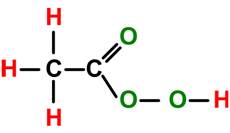What Is Peracetic Acid?
You use it. You smell it. But what is Peracetic Acid (PAA)? Also known as peroxyacetic acid, PAA is a disinfectant used in healthcare and many other industries. It is a highly effective antimicrobial/biocide showing good efficacy against a broad spectrum of pathogens. PAA typically occurs as an equilibrium mixture of acetic acid (the acid in vinegar) and hydrogen peroxide (H2O2). After use and upon reaction, PAA breaks down to acetic acid and water, with no harmful byproducts, giving it its environmental friendly qualities. However, even though PAA is environmentally friendly, it is unfortunately not employee friendly. It is a highly corrosive chemical that can severely irritate and burn the skin and eyes, and vapors can cause irritation as well. It is important to take safety precautions (according to manufacturers’ instructions) when working with and around Peracetic Acid.
Peracetic Acids Effects on Cells
The method by which PAA attacks pathogens is through the reaction with the cellular walls. This reaction leads to the breakdown of cell membranes and cellular death due to cell content leakage. It is similar to popping bubble wrap or a water balloon: the contents of the item spill out, making the item lose shape. Rupturing the cell wall or cell membrane will result in the cell’s death. In addition to reacting with the cell membrane, PAA reacts with and interrupts various processes inside the cell. Once inside, PAA acts on the bases of DNA molecules, hindering cellular replication. PAA will also interfere with molecular functions by reacting with double bonds. In summary, PAA can destroy cells through a variety of attacks!
Peracetic Acid Health Risks
PAA can cause a combination of harmful medical effects, including eye irritation and damage, shortness of breath and respiratory irritation, skin redness, irritation, and blisters, along with pulmonary edema (the build-up of fluid in the lungs). Plus, PAA can present a number of physical hazards as well, since it is a strong oxidant. PAA reacts with combustible fuels such as paper, so sawdust must never be used to clean up PAA spills. PAA will also react with many common metals, such as brass, copper, iron, and zinc and will cause severe corrosion. These metals and their ions can cause PAA to decompose, sometimes violently.
Our Peracetic Acid (PAA) Monitors can be found here.
Contact Us Here, for any of your gas sensing needs!
Source: CHEMdaq Incorporated Blog

